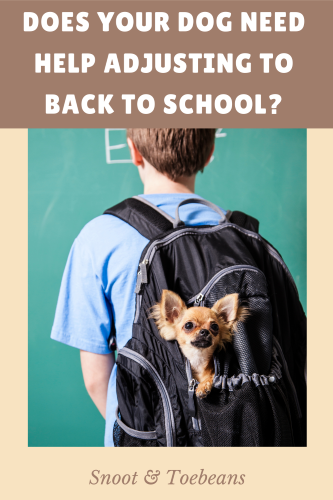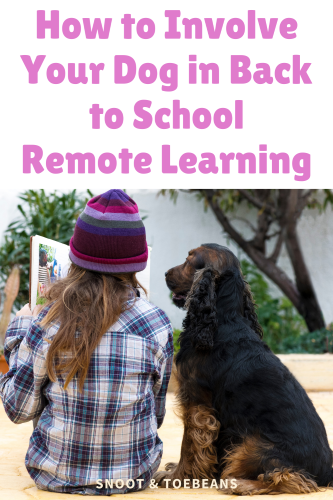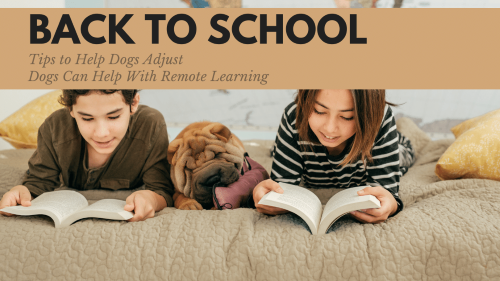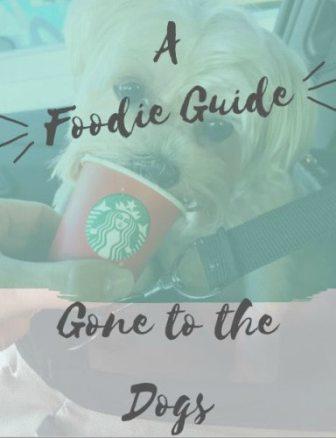Disclosure: My dog blog is supported by dog parents just like you. I only recommend products that I would use on my dogs. All opinions expressed here are my own. I sometimes earn a small affiliate commission, at no extra cost to you, when you click through the affiliate link and purchase something. You can read more about my affiliate policy here.
It’s back to school time! However, this school year will not look the same for everyone. Some of your kiddos will be remote learning from home, while others will be attending school. Therefore, back to school for dogs will not look the same, either!
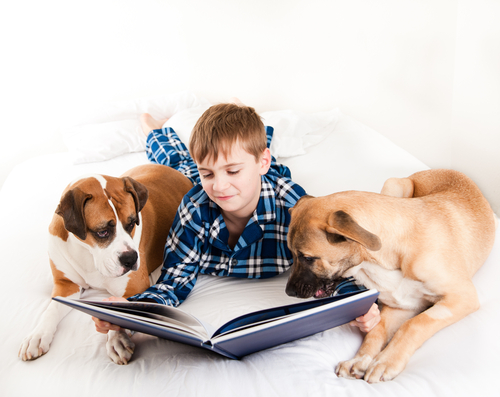
Whether your kids are remote learning or attending school, there will be change in your family routine. Consequently, going back to school for dogs means adjusting to that change.
Furthermore, your dog has had your kids home since March, due to the pandemic. In fact, in a lot of situations, the whole family has been home with your dog. So, nearly three extra months could make for a harder adjustment.
Even if your children will remotely learn from home, your family routine will likely shift. As a result, this change can be stressful on some dogs. Therefore, it is important to help your dog adjust!
Back to School for Dogs – Tips for Adjusting
Go ahead and add those nearly three extra months from school closures to the summer months. Wow! Your dog has enjoyed almost a half of a year with constant family interaction.
However, with the family either going back to school or work, your dog is suddenly alone. Being alone is a tough transition for humans, but for dogs it’s especially tough. For instance, they don’t have the capability to understand why everybody left.
Furthermore, they don’t know if anyone is coming back. Therefore, fear, worry and anxiety more than likely will result. But, we have some back to school for dogs tips below that may help with transitioning to the change in family routine.
1. Mimic Your Back to School Routine For Dogs Before it Starts
Start practicing your family routine before school actually starts. Easing into this transition will help prevent separation anxiety when school begins. Firstly, prepare your dog by leaving the house for short periods of time. Then, you can gradually extend the time you’re gone.
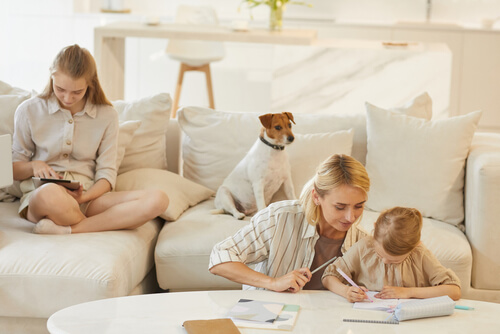
Most importantly, plan ahead what you want your dog’s routine to look like within your family routine. For instance, take your dog out for a bathroom break or walk at the same time both morning and evening.
In addition, plan a regular meal time for morning and evening. Your dog will feel some normalcy when walking and feeding routines are at the same time each day. Furthermore, there will be less confusion and stress for your dog.
Do you have a social dog who enjoys car rides? If you are working from home, take your dog when you drop the kids off at school. Or, if you walk your kids to the bus stop, take your dog along for the walk.
2. Plan for Exercise and Play Time
Be sure to set some time aside each morning to exercise your dog. For example, a walk, a game of fetch, or a short training session will tire out your dog. In fact, your dog will probably be ready to take a nap!
Furthermore, your dog needs physical activity and exercise to stay healthy. However, they also need it to help prevent boredom. Physical activity and exercise can solve the problem of destructive behavior.
So, be sure to leave enough time in the mornings for about 30 minutes of exercise or play. However, don’t limit this to just morning! Schedule another exercise or play time in the afternoon with the kids.
Above all, it is important to remember that your dog has waited all day to spend time with you. Therefore, do your best to make him or her a priority. For example, set up a rotating schedule between all family members once everyone is home. Blocking out at least 20 minutes will help keep your dog content.
3. Create Mental Stimulation for Alone Time
There are several ways to keep your dog mentally engaged during the day when the family is gone.
- Provide them with enrichment that can be enjoyed independently, such as hidden treats in boxes, food puzzles, stuffed Kongs, etc.
- Play soothing music, such as reggae, smooth jazz, classical, or play the TV or radio on stations like the BBC or NPR, while you’re gone. This will keep them from being startled by outside noises. You can also try a white noise machine.
- Leave a dog treat dispenser camera on. This will let you see, talk to, and dispense treats to your dog while you are gone.
Keep in mind, your dog will be going from hearing family voices constantly to just silence.
4. Family Needs to Leave and Return in a Calm Manner
Don’t make a big deal about leaving for the day or returning back home. For instance, it will be tempting to smother your dog with kisses and goodbyes or hellos.
However, for some dogs this could trigger their anticipation of your departure. As a result, anxiety could set in with habitual whining or barking after you’re gone. Furthermore, making a big deal when returning home will further establish the length of time you’ve been gone.
Get in the kissing and hugging a good 30 minutes before your departure. Then, when it is time to leave, just say a quick and calm goodbye. When you return, set bags down, get homework out, and let your dog out. In other words, keep it calm. Then, you can shower your dog with the love and attention they need and deserve.
Help your kids practice this and explain to them the reasoning.
5. Seek Professional Help
Sometimes, all of the above just doesn’t seem to help with a dog’s adjustment to being left alone. Therefore, if this is your dog, then you might need to seek professional help. And, that’s okay.
Most importantly, don’t punish your dog’s behavior. Punishing could actually worsen the behavior. Instead, try one of the following:
- Send your dog to doggy daycare. Even if you only do this a couple of times a week, it will ensure your dog’s alone time is lessened.
- Hire a dog walker. By doing so, your dog will get a potty break, some exercise, and some basic social interaction. Therefore, he or she will be a happier dog when everybody returns.
- Seek the help of a qualified behavior specialist. Your dog’s separation anxiety or other serious behavioral issues should be addressed early on.
Back to School for Dogs – Helping with Remote Learning
For some of you going back to school means remote learning from home this school year. The upside for your dog is you’ll still be home!
However, the downside is that you and the kids will be busy with school work. And, this means that your dog will want attention and could become a distraction. Therefore, plan now to incorporate your dog into remote learning with your kids!
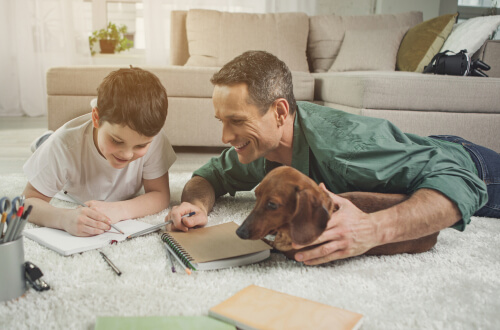
We have some back to school for dogs ideas for you. For instance, you can use an enrichment game with your dog as a reward when completing school work. Let the kids take their breaks by teaching your dog new tricks, or training a new skill. This way, everybody is learning.
As a result, your dog will be happy and tired! Therefore, the kids can finish their school work without a distraction. But, don’t stop there! Try giving your kids some DIY projects to create for your dog.
Certainly, these projects can be done as creative enrichment before focusing on a longer school assignment. This will give the kids a chance to do something fun! Furthermore, the crafts will give your dog something fun to do when the kids get back to work.
Here are a few DIY kibble/treat puzzle projects to try:
- Make a puzzle using an empty egg carton. Put kibble or treats in the slots and fasten the lid. This will keep your dog busy trying to open the container to get inside.
- Use an empty toilet paper tube to make a puzzle. Close one end using masking tape. Then, fill it with kibble or treats. After that, close the end with more masking tape. Again, your dog will stay busy trying to get inside of the tube.
- Poke a few holes in an empty tissue box to make a puzzle. Next, place kibble or treats inside. Then, close up the opening with masking or duct tape. The kibble or treats will fall out as your dog plays with it.
- Another puzzle can be made using a paper bag. Put kibble or treats inside and fold it over. Next, rattle the bag and throw it to your dog. This puzzle will not take long for your dog to shred to get to the goodies inside.
- If the weather is warm, create a frozen puzzle. In an ice tray, place kibble or treats with water and freeze. Then, let your dog lick away to the goodies. Outside, of course!
Have your kids get creative with the puzzles above by decorating them using crayons or markers. In addition, check out more ideas from the American Kennel Club and Humane Society.
Dogs Can Help with Reading and Writing During Remote Learning
During my years teaching kindergarten, I discovered that kids absolutely love to write about their pets. Similarly, they love to read about and be read to about pets, especially stories about dogs.
Although my experience was with kindergarteners, I think kids of all ages enjoy reading and writing about pets. If your child isn’t writing yet, let them dictate a pet story to you. Then, they can illustrate the pages of little books you create together.
Furthermore, I discovered that many different aged students are too nervous or shy to read out loud. If this is your child, try having her or him practice reading to your dog.
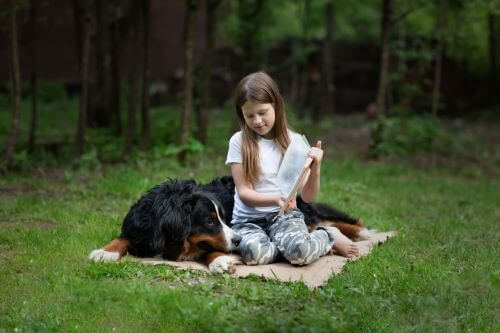
In fact, this isn’t a novel idea! There are many therapy dog programs in place, specifically designed for kids to read to dogs. Consequently, a dog will certainly not judge! Furthermore, for the child, it boosts their reading confidence.
Since your child is remote learning, you can create your own dog assisted program in your home. Most importantly, your child and your dog need to have an established positive, mutually respectful relationship. Plus, they should enjoy spending time together.
Firstly, create a book nook in a quiet spot where they both feel comfortable. For example, a sofa, window seat, or corner of your child’s bedroom can make a great book nook.
Secondly, add a basket of age-appropriate reading material to the book nook. Next, condition your child and dog that the book nook is a calm and quiet time for reading. Next, encourage your child to read to your dog.
After your dog has listened for a little bit, reward him or her with a healthy treat. Furthermore, this will reinforce that spending time in the book nook with your child is a good thing.
Dogs Helping with Reading Continued
On the contrary, if your dog is not cooperative, your child can still practice reading to a dog. A Washington-based nonprofit group called, PAL – People.Animals.Love, has switched from in-person to virtual sessions.
During the pandemic, they are serving hundreds of kids per month who are practicing reading. On their site, you register your child for a free “Read to a PAL Therapy Dog!” session.
“Animals can assist kids in a number of areas such as communication, self confidence, risk taking, creativity, playfulness, motivation, unconditional acceptance, companionship and individual learning.”
Dr. Lori Friesen, author of How Your Dog Can Help your Child, Read, Lead and Succeed
Furthermore, including your dog in the reading practice will help with feeling included in the remote learning routine.
Dogs and Math, Science, and Social Studies
Perhaps your child struggles in math! So, try incorporating daily math conversations about your dog’s caregiving calculations. For instance, count the treats given in a day. Then, figure out how many will be given for the week.
Furthermore, create math conversations involving dog years, dog food servings and finding distance on walks. For example, 3 miles walking a day equals enough exercise for your dog. Plus, you walk your dog at a track that is a quarter mile around. So, you can have your child figure out how many laps will equal the 3 miles needed.
Have a budding scientist in the house? Your child can study the genetic traits of the family dog. For instance, behaviors, coats, and coloring. If your family dog is a Border Collie, then your child will learn about herding instincts. Furthermore, they will learn that the family dog was bred to herd sheep and cattle.
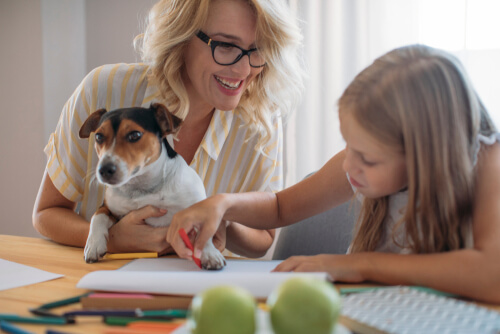
How about social studies? Does your child enjoy looking at maps? You can create a dog breed study and locate their origin on a map. Furthermore, use a large map, so you can pin dog breed photos to their location of origin. Your child will love seeing all of the different countries that the dog breeds come from. They will discover that the American Cocker Spaniel, Boston Terrier, and Pit-bull all originated from the USA.
In Conclusion
I hope you’ve discovered that back to school for dogs doesn’t have to be stressful for the family. Nor does remote learning with your dog have to be stressful.
So, with a little planning and preparation with the tips above, your dog will be set with a smooth back to school transition. And, with our educational ideas, you will feel more prepared for your child and dog remote learning from home.
Do you have any tips on going back to school for dogs you can share? We would love to read about them in the comments below. How about any tips on remote learning with dogs? Let us know in the comments below.
You might like the following post with great tips for going back to work:
Or, you might like one of our dog treat recipes to use as a reward for your dog:
If you want to pin this post to Pinterest, you can use one of the following images.
